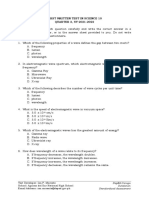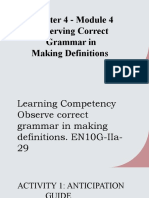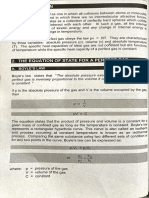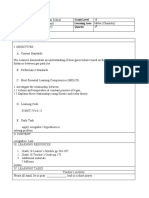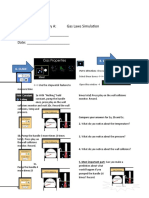3rdQUARTER EXAM SCIENCE 10
3rdQUARTER EXAM SCIENCE 10
Uploaded by
Lani Bernardo CuadraCopyright:
Available Formats
3rdQUARTER EXAM SCIENCE 10
3rdQUARTER EXAM SCIENCE 10
Uploaded by
Lani Bernardo CuadraCopyright
Available Formats
Share this document
Did you find this document useful?
Is this content inappropriate?
Copyright:
Available Formats
3rdQUARTER EXAM SCIENCE 10
3rdQUARTER EXAM SCIENCE 10
Uploaded by
Lani Bernardo CuadraCopyright:
Available Formats
Republic of the Philippines
Department of Education
Region III
Schools Division of Nueva Ecija
ST. JOSEPH HIGH SCHOOL, CABIAO ANNEX
Cabiao, Nueva Ecija
NAME:____________________________________________DATE:__________________
GRADE:___________________________________________SCORE:_________________
THIRD QUARTER EXAMINATION
SCIENCE 10
I. Read the statements or questions carefully and then shade the letter of the correct answer from the choices given
before each number.
1. Which of the following shows that mutation is harmful among organisms?
A. Livestock such as hogs and poultry can now produce more young.
B. Mutation in plants may result in their inability to make chlorophyll.
C. New varieties of crops were produced that are resistant to pests or diseases.
D. There are fruits and vegetable which were genetically modified to stay unripe longer.
2. What will be the result when there is an error in the base pairing of the DNA?
A. The DNA sequence will be changed resulting to non-functional protein.
B. The translation of nucleotide bases in DNA into amino acids becomes faster.
C. The transcription of information from the DNA to mRNA will not be possible.
D. All of the given choices.
3. All, EXCEPT ONE, might cause a mutation to occur. What is the exception?
A. high-energy radiation C. exposure to extreme temperature
B. chemicals reacting with DNA D. over consumption of junk foods
4. Deletion involves the loss of a segment of DNA or chromosome. Which of the following base pairing
shows this chromosomal mutation?
A. C.
141 142 143 144 145 141 142 143 144 145
GCC ATT TTT GGC CCT GCC ATT TTT GGC CCT
GCC ATT TTG GCC TT… GCC ATT TTG CGG CTT
B. D.
141 142 143 144 145 141 142 143 144 145
GCC ATT TTT GGC CCT GCC ATT TTT GGC CCT
CCT GGC TTT ATT GCC GCC TTA TTG CGG CTT
5. A paleontologist conducted relative dating to a fossil. What possible information will he obtain from
this procedure?
A. relative age of the fossil C. time scale
B. half-life D. chemical component
6. The fossil record of animal evolution is incomplete. Which of the following help explain this
observation?
I. Some strata have not yet been exposed to reveal their fossil content.
II. Previous breaking, heating, and bending of rocks have altered some fossils beyond
recognition.
III. Erosion removed many sedimentary rocks and their fossil content has been destroyed.
A. I, II, and III B. II and III only C. 1 and II only D. II only
7. The picture at the right is a specimen discovered from the Solnhofen limestone in
Bavaria, Southern Germany. This is known as
A. fossil C. biological remain
B. artifact D. mineralized rock
8. In what era can the oldest fossils be found?
A. Cenozoic B. Mesozoic C. Paleozoic D. Pre Cambrian
9. How does the Geologic Time Scale help you understand about life in the geologic past?
A. It provides a fossil record of organisms that dominated each period of time.
B. It corresponds to various organisms that evolved geometrically over time.
C. It gives information about the evolution of selected animals.
D. It gives the age of older rock layers on Earth.
10. Which of the following statements is TRUE about morphology and patterns of development?
A. Comparative morphology reveals homologous structures, shared as a result of descent from a
common ancestor.
B. Comparative biochemistry disregards genetic mutations that have accumulated in different
species.
C. Embryological evidences suggests many flaws in the homology and analogy of evolutionary
trends.
D. Embryological evidences reveal inaccuracy in evolutionary developmental patterns.
11. The forelimbs of bat and whale are said to be homologous structures. What does this indicate?
A. Bats and whales have the same ancestor.
B. Bats and whales have different ancestors.
C. The forelimbs of bats and whales are adapted to similar functions.
D. None among the given choices.
12. If two species exhibit similar embryonic development, they
A. belong to different ancestors since embryos become more and more dissimilar.
B. have the similar DNA and amino acid sequences.
C. came from the same parents.
D. are closely related.
For items 13-15, refer to the following choices.
A. Adaptation B. Acquisition C. Reproduction D. Variation
13. The neck of giraffes varies in length such that giraffes with long necks survived when there is
shortage of food and competition.
14. In Galapagos Island, Darwin observed that finch species have different beak structures for different
food types.
15. Two organisms from survival populations of the same species may mate together and shift the
abundance of a new breed of organism due to mutation.
16. Which of the following statements best explains the Theory of Natural Selection?
A. Organs that are not used may disappear, while organs that are constantly used may develop.
B. In nature, the organism with desirable characteristics may survive, while those with weaker
traits may not.
C. Organisms develop desirable structures to survive in a given environment.
D. Acquired characteristics of parents can be passed on to off springs.
17. Which of the following statements supports the idea that extinction is necessary?
A. To give way for other organisms to develop
B. To let other organisms evolve and progress
C. To know who is the fittest
D. All of the above.
18. Mammoth were mammals which existed during the ice ages but were considered as extinct in the
present times. What is the possible reason for this?
A. Changes in environmental conditions caused those less fit to be eliminated.
B. New species of organisms was introduced in the environment which preyed these organisms
until extinction.
C. A catastrophic even took place eliminating the whole population of mammoths.
D. All of the above.
19. A person breeds guinea pigs in a cage. After a few generation, the breeder observes that the guinea
pigs are more aggressive towards each other, the young are less healthy and more guinea pigs die.
What do you think will happen to the population of the guinea pigs?
A. The population will remain the same. C. The population will decrease.
B. The population will increase. D. The population is not affected.
20. An ecosystem is said to be stable if
A. the population density of prominent organisms remains the same as years pass by.
B. it is resilient enough to withstand changes that may occur in the environment.
C. it is not affected by calamities brought about by nature or by man.
D. there is an abundant biodiversity of organisms living together.
21. How does species biodiversity benefit an ecosystem?
A. Some plants and animals provide raw materials needed in the production of economic
valuable products.
B. Certain species maintain the chemical quality of natural bodies of water, prevent soil erosion
and floods, cycle materials in the soil, and absorb pollutants.
C. A lot of species provides visual or aesthetic enjoyment like landscapes and parks.
D. All of the above
22. In what aspect species diversity increases the probability of a stable environment?
A. Different species have different roles in the ecosystem making it balance and stable.
B. A rich species biodiversity allows the appearance of
new organisms which can sustain the
ecosystem.
C. A strong competition among diverse species allows
the survival of the fittest.
D. Interrelationship of organisms maintains a stable
environmental condition preventing the
occurrences of natural disasters. Pop
ulation Growth of Breeding
Male Fur Seals
For items 23-28, refer to the given graph on the right.
23. In what year the population of fur seals first reached its carrying capacity?
A. 1915 C. 1935
B. 1925 D. 1945
24. What does the graph show?
A. There is no growth at all in the population of fur seals.
B. Fur seals ‘s population exhibited logistic growth.
C. Fur seals’ population exhibited exponential growth.
D. The population of fur seals undergone both logistic and exponential growth.
25. The population of fur seals eventually reached its carrying capacity. This means that
A. resources became limited causing the growth of population to level off.
B. resources are unlimited causing the population to grow exponentially.
C. the ecosystem sustains the fur seals well causing a stable population.
D. the ecosystem can no longer sustain fur seals and eventually may lead to extinction.
26. What were the possible outcomes as these organisms reached their carrying capacity?
I. There will be competition for food among fur seals.
II. There will be more cases of fur seals contracted with diseases.
III. Emigration takes place as fur seals search for place with enough resources.
IV. Predators of fur seals will increase in population since there are plenty of prey.
A. I and II B. III and IV C. I, II, III and IV D. None among I, II, III and IV
27. Suppose the year 1950, the population of fur seals started to decreases due to density-independent
limiting factor, we can assume that
A. humans started to invade and alter the habitat of fur seals.
B. a natural disaster took place which killed some of the fur seals.
C. there was a drastic change in the temperature of the area where the fur seals live.
D. All of the above.
28. Which of the following causes a decreasing wildlife population in most of the places of our country?
A. loss of limiting factor C. loss of habitat
B. loss of natural disturbances D. loss of carrying capacity
29. What gas law explains the relationship among the volume, pressure, temperature, and the
number of moles of gases?
A. Boyle’s Law C. Charle’s Law
B. Combined Gas Law D. Ideal Gas Law
30. Don can still pump air in the party balloon even though it is already inflated. What explain this
phenomenon?
A. Balloons are elastic. C. The air inside the balloon is hot.
B. Balloons are made up of plastic. D. Air molecules can be compressed.
31. What is most likely to happen when an aerosol can is heated?
A. The can will be deformed. C. The can will eventually explode.
B. The can will stay the same. D. The can will tarnish.
For items 32-33, refer to the given information.
Each container with varying volume has 1 mole of oxygen gas at 30.0 0 C.
C- 3 L D- 4 L
A- 1 L B- 2 L
32. What is TRUE about the pressure in the four containers?
A. Container D has the least pressure while container A has the greatest pressure.
B. Container D has the greatest pressure while container A has the least pressure.
C. Containers B and C has greater pressure than Containers A and D.
D. The pressure is the same in containers A, B, C, and D.
33. What can be inferred among volume, pressure, and temperature of the oxygen gas?
A. The volume of the gas is inversely related to its pressure at constant temperature.
B. The volume of the gas is directly related to its pressure at constant temperature.
C. The temperature of the gas is directly related to its volume at constant pressure.
D. The temperature of the gas is inversely related to its pressure at constant pressure.
34. Gab wants to have a portable oxygen tank. A 10.00 liter oxygen gas exerts a pressure of 2.00
atmosphere. How much pressure is needed for this gas to be compressed in a 2.00 Liter
cylinder, provided, there is no temperature change?
A. 2. 5 atm B. 5 atm C. 7.5 atm D. 10 atm
35. The temperature of nitrogen gas contained in a not rigid vessel is increased from 5.0 0 C to 1000C?
Which of the following describes the resulting behavior of nitrogen gas molecules?
I. The average kinetic energy suddenly increases, thus the pressure decreases.
II. The average kinetic energy suddenly decreases, thus the pressure decreases.
III. The volume occupied by the gas molecules suddenly increases, thus the container expands.
IV. The volume occupied by the gas molecules suddenly decreases, thus the container shrink.
A. I & III B. II and IV C. I & IV D. II & III
36. What do you expect to happen to the volume of a gas if its pressure is reduced to half and its
temperature is doubled?
A. Its volume is reduced into half.
B. Its volume is increased four times
C. Its volume remains unchanged.
D. Its volume is doubled.
For items 37-38, refer to the given situation.
On a hot summer day, while you are on a trip to Vigan City, the tire of your car suddenly exploded.
37. Which of the following depicts the gas molecules inside the tire just before it exploded?
A. The gas molecules were side by side with small spaces between them.
B. The gas molecules were a little farther from each other forming weak bonds.
C. The gas molecules moved vigorously colliding with each other and with the walls of the tire.
D. The gas molecules individually increased in size, occupying the whole space inside the tire.
38. Which of the following could explain this phenomenon?
A. There was too much air inside the tire.
B. The tire of the vehicle was not properly maintained.
C. Since its summer, there were more travelers.
D. The air inside the tire expanded due to the high temperature.
For items 39-41, refer to the situation below.
“LPG or liquefied petroleum gas is contained at a container with constant volume and high pressure.”
39. What can be said on the temperature of the gas?
A. The temperature is absolute zero. C. The temperature is at maximum.
B. The temperature is at minimum. D. the temperature exceeds boiling point of water.
40. What caused the gas to be liquefied?
A. Due to high pressure, gas molecules were compressed resulting to a phase change.
B. The volume of the gas was ideal for it to change from gas to liquid.
C. The total kinetic energy of the gas molecules were equated to zero.
D. None of the above.
41. What will happen to the temperature of the gas as the pressure decreases?
A. The gas temperature stays the same. C. The gas temperature increases.
B. The gas temperature decreases. D. There is no enough data.
II. Answer the following questions.
A. The Philippines, being surrounded with bodies of water, has vast areas where coral reefs tribe. How should this
ecosystem be protected to conserve its resources? Choose one among the given choices and explain your choice. (3pts)
Scoring: 3 pts- Correct answer with proper and enough justification 2- correct answer incomplete justification 1- Wrong answer
0- no answer
A. Promote it as an ecotourism destination.
B. Collect coral fishes and sell them to pet shops.
C. Collect corals as souvenir items for tourists.
B. The following depicts the formation of methanol (CH 3OH)
Carbon + Hydrogen gas + Oxygen Gas methanol
45. What is/are the reactant/s in the given chemical reaction?
46. What is/are the product/s in the given chemical reaction?
47-48. What would be the skeleton equation for this reaction?
49-50. What would be the balanced chemical equation for this reaction?
“ Much good work is lost for the lack of a little more.”
PREPARED BY:
LANI BERNARDO CUADRA
TEACHER II
NOTED BY:
MARIA MERLISSA V. MANUEL Ph.D
TEACHER-IN-CHARGE
You might also like
- Philo - Mod1-Q1 Introduction To The Philosophy of The Human Person v3Document26 pagesPhilo - Mod1-Q1 Introduction To The Philosophy of The Human Person v3Lani Bernardo Cuadra89% (101)
- Grade-11-Philo - Q1 Mod 2 Method of Philospphizing v3Document26 pagesGrade-11-Philo - Q1 Mod 2 Method of Philospphizing v3Lani Bernardo Cuadra82% (99)
- Philo - Mod1-Q1 Introduction To The Philosophy of The Human Person v3Document26 pagesPhilo - Mod1-Q1 Introduction To The Philosophy of The Human Person v3Lani Bernardo Cuadra89% (101)
- Grade-11-Philo - Q1 Mod 2 Method of Philospphizing v3Document26 pagesGrade-11-Philo - Q1 Mod 2 Method of Philospphizing v3Lani Bernardo Cuadra82% (99)
- 3rd Quarter Test Paper (Grade 7-Science)Document7 pages3rd Quarter Test Paper (Grade 7-Science)Lani Bernardo Cuadra95% (19)
- 2nd QUARTER EXAM SCIENCE 10Document9 pages2nd QUARTER EXAM SCIENCE 10Lani Bernardo Cuadra85% (20)
- General Organic and Biochemistry Connecting Chemistry To Your Life Second Edition PDFDocument886 pagesGeneral Organic and Biochemistry Connecting Chemistry To Your Life Second Edition PDF12k6100% (6)
- IntroPhilo11 - Q1 - Mod3 - The Human Person As An Embodied Spirit - Version 3Document22 pagesIntroPhilo11 - Q1 - Mod3 - The Human Person As An Embodied Spirit - Version 3Lani Bernardo Cuadra85% (73)
- 1st Periodic Test - Science 7Document5 pages1st Periodic Test - Science 7Lani Bernardo Cuadra93% (68)
- 2nd QUARTER EXAM IN GRADE 7 SCIENCEDocument7 pages2nd QUARTER EXAM IN GRADE 7 SCIENCELani Bernardo Cuadra88% (49)
- FINAL 2ND PERIODICAL EXAM SCIENCE 10 2K23 A4 SizeDocument10 pagesFINAL 2ND PERIODICAL EXAM SCIENCE 10 2K23 A4 Sizemaverick arquilloNo ratings yet
- Science 10 First QuarterDocument52 pagesScience 10 First QuarterLani Bernardo Cuadra67% (3)
- Science 10 First QuarterDocument52 pagesScience 10 First QuarterLani Bernardo Cuadra67% (3)
- Illustrated Teacher's Guide: Scientists and Their Discoveries: The Ideal Gas Law PosterDocument7 pagesIllustrated Teacher's Guide: Scientists and Their Discoveries: The Ideal Gas Law PosterRonaldo ManaoatNo ratings yet
- GLWS9Document6 pagesGLWS9Vince HernándezNo ratings yet
- Q3 EXAM MAPEH10 No Answer KeyDocument5 pagesQ3 EXAM MAPEH10 No Answer KeyNivlem AyartNo ratings yet
- English 10 3rd ReviewedDocument6 pagesEnglish 10 3rd ReviewedShanrey MironesNo ratings yet
- English Q2 Module-3-4 Edited PDFDocument21 pagesEnglish Q2 Module-3-4 Edited PDFClash Of Clans acc2No ratings yet
- Third Written Test in Science 9 QUARTER 4, SY 2021-2022: ST ND RDDocument6 pagesThird Written Test in Science 9 QUARTER 4, SY 2021-2022: ST ND RDjoan marie PeliasNo ratings yet
- Research Grade 10 SSC & STE Q1 ReviewerDocument5 pagesResearch Grade 10 SSC & STE Q1 ReviewerAzriel Kenji Encarnacion100% (1)
- Science10 q4 Mod1 Boyleslaw v5Document18 pagesScience10 q4 Mod1 Boyleslaw v5Vicente SazilNo ratings yet
- Arts10 Q3 Ver4 Mod1Document35 pagesArts10 Q3 Ver4 Mod1Yanna QoNo ratings yet
- Second Periodic Test Grade10Document5 pagesSecond Periodic Test Grade10Marl Rina EsperanzaNo ratings yet
- Math 10 2nd Periodical Exam 1Document8 pagesMath 10 2nd Periodical Exam 1Amelia MorenoNo ratings yet
- Science 10 ReviewDocument3 pagesScience 10 ReviewMarl Rina EsperanzaNo ratings yet
- Sci10 LM U2Document147 pagesSci10 LM U2MikhaellaNo ratings yet
- Second Written Test in Science 9 QUARTER 4, SY 2021-2022Document5 pagesSecond Written Test in Science 9 QUARTER 4, SY 2021-2022joan marie PeliasNo ratings yet
- Dna and Rna DLLDocument2 pagesDna and Rna DLLHeidie BalabboNo ratings yet
- Science10 q4 Mod4 Biomoleculescarbohydrates v5Document32 pagesScience10 q4 Mod4 Biomoleculescarbohydrates v5Vicente SazilNo ratings yet
- Chemical Reactions: For Advanced Chemistry Special Science High School in Grade 10 Quarter 3/ Week1Document12 pagesChemical Reactions: For Advanced Chemistry Special Science High School in Grade 10 Quarter 3/ Week1Venice Gwyn ChavezNo ratings yet
- S10 - Q2 - Summative Test 1Document5 pagesS10 - Q2 - Summative Test 1Letsirk Saluta Ramos100% (1)
- Peterpaul Nacua@deped Gov PHDocument15 pagesPeterpaul Nacua@deped Gov PHGon FrecssNo ratings yet
- SCIENCE 10 Q2 PERIODIC EXAM UneditedDocument7 pagesSCIENCE 10 Q2 PERIODIC EXAM UneditedIvy Joy DaguitNo ratings yet
- Science 10Document4 pagesScience 10Kim Coleen CamasoNo ratings yet
- Science 10 Q3 Module 5 Evidences of EvolutionDocument16 pagesScience 10 Q3 Module 5 Evidences of EvolutionMellida Kate Winslet T.No ratings yet
- Long Test Science 10 2nd QuarterDocument29 pagesLong Test Science 10 2nd QuarterAple RigorNo ratings yet
- Forms of Multimedia in The PhilippinesDocument4 pagesForms of Multimedia in The Philippinesivi pearl dagohoyNo ratings yet
- SCIENCE 10 4th TMTDocument3 pagesSCIENCE 10 4th TMTkaycin Duzon100% (1)
- 2nd Quarter Final 10 MercuryDocument2 pages2nd Quarter Final 10 MercuryJoram Ray Obiedo100% (1)
- English 10 2nd Quarter Module 1.2Document21 pagesEnglish 10 2nd Quarter Module 1.2Jocarl CarinanNo ratings yet
- Science 10 Q3 Week 3Document14 pagesScience 10 Q3 Week 3Crislan D. VillalonNo ratings yet
- Math 10 Pre Test Sy 2023-2024Document4 pagesMath 10 Pre Test Sy 2023-2024Jezreel TanNo ratings yet
- Identifying Effects! Directions:: Learning Task 2Document4 pagesIdentifying Effects! Directions:: Learning Task 2Aeveil PalejaroNo ratings yet
- SUMMATIVE TEST IN SCIENCE 10 Week 3 & 4Document2 pagesSUMMATIVE TEST IN SCIENCE 10 Week 3 & 4Esther Mae Ann TrugilloNo ratings yet
- 2nd Periodical Test - LongquizDocument1 page2nd Periodical Test - Longquizlynmeabayan13No ratings yet
- SCIENCE REVIEWER - 10 (Pre Final Exam)Document8 pagesSCIENCE REVIEWER - 10 (Pre Final Exam)Ellah Marie FlorentinoNo ratings yet
- Science 10 Q4 SLM7Document13 pagesScience 10 Q4 SLM7RAYMUND RODILLO0% (1)
- Math 10 - Q3 M11Document11 pagesMath 10 - Q3 M11Bien DivinaflorNo ratings yet
- 1st Periodic Test - Science 10Document5 pages1st Periodic Test - Science 10Lani Bernardo CuadraNo ratings yet
- Sci10 q2 Second Summative TestDocument2 pagesSci10 q2 Second Summative TestAilyn Carlos-Dizon100% (1)
- Q4 PE 10 Module 1Document15 pagesQ4 PE 10 Module 1anthonneacNo ratings yet
- G10 ScienceQ4 SLM Wk1 (For QA)Document19 pagesG10 ScienceQ4 SLM Wk1 (For QA)Erwin jakob L. MonsaludNo ratings yet
- Q4 Mathematics 10 Module 1Document22 pagesQ4 Mathematics 10 Module 1truepogsNo ratings yet
- Permutations: P (N, R) N! / (N-R) !Document19 pagesPermutations: P (N, R) N! / (N-R) !RENANTE NERANo ratings yet
- EXAM Science 10Document2 pagesEXAM Science 10Yalu EinahpetsNo ratings yet
- A4 Science 10 WEEK 2 Qtr. 2 2020-2021Document5 pagesA4 Science 10 WEEK 2 Qtr. 2 2020-2021ANDREW SALUNDAGUIT100% (1)
- 2nd Quarter Exam in English 10Document3 pages2nd Quarter Exam in English 10Liza Valerio AquinoNo ratings yet
- MULTIPLE CHOICE TEST: Read Each Questions Carefully and Choose The Correct Answer. Write The LetterDocument2 pagesMULTIPLE CHOICE TEST: Read Each Questions Carefully and Choose The Correct Answer. Write The LetterMICHAEL USTARENo ratings yet
- Second Quarterly Examination in Science 10 SY 2022-2023Document12 pagesSecond Quarterly Examination in Science 10 SY 2022-2023Gy FalcasantosNo ratings yet
- Grade 10 Science ReviewerDocument2 pagesGrade 10 Science ReviewerVannie MonderoNo ratings yet
- 1ST Quarter Exam Science 10Document8 pages1ST Quarter Exam Science 10Bryan de VeraNo ratings yet
- SCIENCE G10Wk3Document28 pagesSCIENCE G10Wk3magnificentnazhpro100% (1)
- Music 10 - 3Q - 3aDocument12 pagesMusic 10 - 3Q - 3amjcarbonelforonesNo ratings yet
- Boyle's LawDocument5 pagesBoyle's LawKyle Ambis SyNo ratings yet
- 1Q Exam in Mapeh 10Document4 pages1Q Exam in Mapeh 10Dianne Mae DagaNo ratings yet
- 3rd Periodic Test-Grade 10Document6 pages3rd Periodic Test-Grade 10Ailene CeriloNo ratings yet
- Third Quarter Exam in Science 10Document3 pagesThird Quarter Exam in Science 10Marife GuadalupeNo ratings yet
- TQ - English 10Document11 pagesTQ - English 10ofelia guinitaranNo ratings yet
- Science - 10: Name: - Date: - ScoreDocument5 pagesScience - 10: Name: - Date: - ScoreLan CeNo ratings yet
- PP Quarter 4 Module 4Document83 pagesPP Quarter 4 Module 4Dennis AngeloNo ratings yet
- Q2-PPT-HEALTH10 Week 2 (Social Health Related Issues)Document21 pagesQ2-PPT-HEALTH10 Week 2 (Social Health Related Issues)Leonel CaromayanNo ratings yet
- Sci10Q2W5 - EFFECTS OF ELECTROMAGNETIC WAVES - EditedDocument14 pagesSci10Q2W5 - EFFECTS OF ELECTROMAGNETIC WAVES - EditedArchie CabaNo ratings yet
- I. Read The Statements or Questions Carefully and Then Shade The Letter of The Correct Answer From The Choices Given Before Each NumberDocument4 pagesI. Read The Statements or Questions Carefully and Then Shade The Letter of The Correct Answer From The Choices Given Before Each NumberJoel BagalanonNo ratings yet
- 3rdQUARTER EXAM SCIENCE 10Document5 pages3rdQUARTER EXAM SCIENCE 10MadilynNo ratings yet
- Certification For Cash Allowance 2022Document2 pagesCertification For Cash Allowance 2022Lani Bernardo CuadraNo ratings yet
- Endorsement For Cash AllowanceDocument3 pagesEndorsement For Cash AllowanceLani Bernardo CuadraNo ratings yet
- Unit 1 Introduction To The Philosophy of Human PersonDocument19 pagesUnit 1 Introduction To The Philosophy of Human PersonJessa AquitanNo ratings yet
- Endorsement Form 7Document4 pagesEndorsement Form 7Lani Bernardo CuadraNo ratings yet
- Philo - Mod1-Q1 Introduction To The Philosophy of The Human Person v3Document30 pagesPhilo - Mod1-Q1 Introduction To The Philosophy of The Human Person v3Lani Bernardo Cuadra100% (9)
- Science: Quarter 1 - Module 1 Volcano and Its Relation To Plate TectonicsDocument41 pagesScience: Quarter 1 - Module 1 Volcano and Its Relation To Plate TectonicsLani Bernardo Cuadra100% (8)
- 3rd Quarter Examination Science 8Document6 pages3rd Quarter Examination Science 8Lani Bernardo CuadraNo ratings yet
- 1st Periodic Test - Science 9Document4 pages1st Periodic Test - Science 9Lani Bernardo Cuadra100% (1)
- Periodical Test IN UCSPDocument5 pagesPeriodical Test IN UCSPLani Bernardo Cuadra100% (3)
- 1st Periodic Test - Science 10Document5 pages1st Periodic Test - Science 10Lani Bernardo CuadraNo ratings yet
- Philippine Politics and Governance: Political ScienceDocument8 pagesPhilippine Politics and Governance: Political ScienceLani Bernardo CuadraNo ratings yet
- Discussion On PoliticsDocument4 pagesDiscussion On PoliticsLani Bernardo CuadraNo ratings yet
- 1st Periodic Test - Science 8Document3 pages1st Periodic Test - Science 8Lani Bernardo CuadraNo ratings yet
- Balaytigue National High School: Department of EducationDocument7 pagesBalaytigue National High School: Department of EducationRaymond BugagaoNo ratings yet
- Heinz Bloch - Compressor Technology Advances - Beyond (2021)Document492 pagesHeinz Bloch - Compressor Technology Advances - Beyond (2021)caapasa100% (1)
- Boyle's LawDocument40 pagesBoyle's LawGarren Jude AquinoNo ratings yet
- Gaseous State FinalDocument43 pagesGaseous State Finalsadhu50% (2)
- CH - 1 Basics of MeasurementDocument36 pagesCH - 1 Basics of MeasurementSusovan SensharmaNo ratings yet
- Question On GasesDocument9 pagesQuestion On GasesAhmad AlnajjarNo ratings yet
- MCQsDocument6 pagesMCQsKashan NoorNo ratings yet
- Thermal 4Document148 pagesThermal 4AgnolottiNo ratings yet
- Chapter 6 - Gases (Part 1)Document61 pagesChapter 6 - Gases (Part 1)Shivanni PonnusamyNo ratings yet
- A15 Cengel - Gráfica de TermodinámicaDocument1 pageA15 Cengel - Gráfica de Termodinámicalolololprogamer0263No ratings yet
- Pneumatic PowerDocument28 pagesPneumatic PowerghndslNo ratings yet
- Mining Machinery: Department of Mechanical Engineering Aditya Engineering CollegeDocument35 pagesMining Machinery: Department of Mechanical Engineering Aditya Engineering CollegeRAJESH SAHNo ratings yet
- The Equation of State For A Perfect Gas: A. Boyle'S LawDocument9 pagesThe Equation of State For A Perfect Gas: A. Boyle'S LawCzarina Jane PeregrinNo ratings yet
- Boyle's and Charles's Law Lab ReportDocument7 pagesBoyle's and Charles's Law Lab Reportzarinsamanta55No ratings yet
- 4-3 Physics WK 3 Combined Gas LawDocument3 pages4-3 Physics WK 3 Combined Gas Lawlaisha chanNo ratings yet
- Combined Gas Law & Dalton's Law (G4)Document37 pagesCombined Gas Law & Dalton's Law (G4)Kesziah CalambaNo ratings yet
- Final Exam in Science 10Document4 pagesFinal Exam in Science 10Daiseree SalvadorNo ratings yet
- Grade 10 Science LP Week 4Document18 pagesGrade 10 Science LP Week 4Venicer BalaodNo ratings yet
- Unit 8 - Behavior of GasesDocument24 pagesUnit 8 - Behavior of GasesNenbon NatividadNo ratings yet
- Chem 103 (Vincent Korboi)Document7 pagesChem 103 (Vincent Korboi)villedelron7No ratings yet
- Name: - Yr. and Section: - Date: - Exercise #10 Gas Laws Boyle's Law ProblemsDocument2 pagesName: - Yr. and Section: - Date: - Exercise #10 Gas Laws Boyle's Law ProblemsKeannoNo ratings yet
- ISM Chapter10-Part1Document33 pagesISM Chapter10-Part1AyaNo ratings yet
- SS2 First Term Lesson NoteDocument58 pagesSS2 First Term Lesson Noteojo ayodeji johnsonNo ratings yet
- GasesDocument14 pagesGasesArdee MendozaNo ratings yet
- 3.1.1 Thermal PhysicsDocument42 pages3.1.1 Thermal Physics윤No ratings yet
- Module 1Document24 pagesModule 1G02 - BALACANAO JHERICE A.No ratings yet
- Phet - Gas Laws in html5Document5 pagesPhet - Gas Laws in html5api-573214664No ratings yet



























